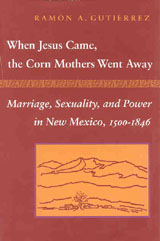Actually, the Corn Mother is still around—but structuralism has left the building…

Ramón Gutierrez’s book When Jesus Came, The Corn Mothers Went Away is a perfect example of why academics have turned away from structural analysis a la Claude Levi-Strauss.
There is a copy of Levi-Strauss sitting on my bookshelf. I purchased it in undergrad for a course in symbolic anthropology, and I enjoyed the mental acrobatics it afforded me. In my undergraduate course, each student completed a structural analysis of a myth. I analyzed the Cherokee creation myth, and the story of Selu, the Cherokee Corn Mother. The point of all this was not to teach me the secrets of ethnographic analysis, but to impart a bit of the history of theory. After the papers were turned in, we learned about the flaws inherent in the structural method. Oversimplification, the creation of misleading Cartesian dualisms, and the deceptive ease of the method are some of structuralism’s weaknesses that are most readily apparent in When Jesus Came, The Corn Mothers Went Away.
The opening chapter analyzes a Pueblo origin myth in classic structuralist style. Earth and sky, male and female, corn and flint—the oversimplification into essentialist blocks that can be sorted into opposing piles of index cards (in true structuralist fashion) is maddening! Also, throughout this chapter, the author assumes a 1:1 relationship between the present and the past that is problematic at best. He addresses this issue in the introduction: “Skeptics can easily counter … pointing out that symbols and practices can remain constant even though their meanings change; meanings can remain identical despite a radical change in the outward appearance of symbols and practices” (xxx). While Gutierrez acknowledges this, he does nothing to reassure the reader that he has not missed the point entirely.
He catalogues what he sees as the wholesale destruction of Indian culture, for example, the replacement of solstice with Christmas, and the replacement of the Corn Mother with the Virgin Mary. The whole book smacks of the reduction inherent in an unsophisticated application of Strauss.
Finally, the title itself is exceedingly annoying. It speaks to the “Myth of Desolation” (the idea that the Spanish Conquest destroyed indigenous cultures wholesale) that Matthew Restall identifies in Seven Myths of the Spanish Conquest as one of the biggest and most persistent problems in Latin American historiography. In reality, the idea of a Native American Corn Mother still exists today. Frustrated readers of Gutierrez would do well to read Cherokee author and poet Marilou Awiakta’s Selu: Seeking the Corn Mother’s Wisdom, published in 1994. The book is a testament to the vitality of the idea of the Corn Mother, and to her relevance to Native American spirituality today.
